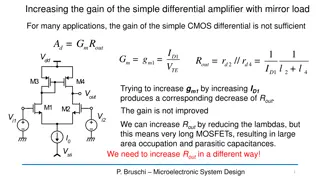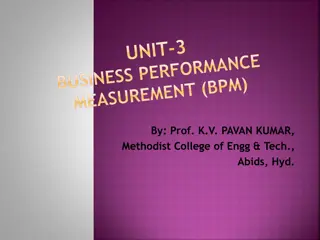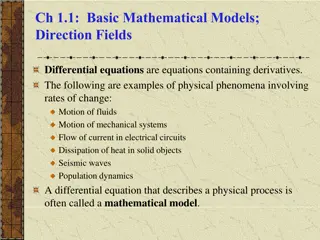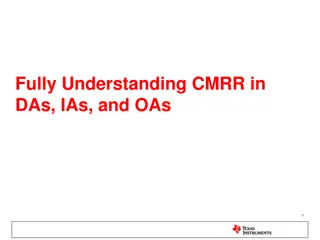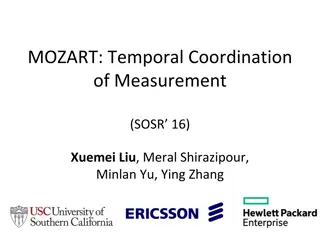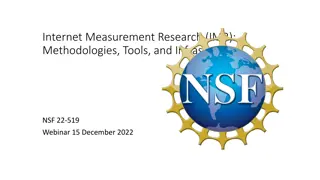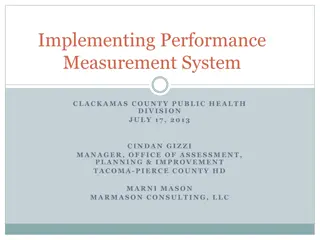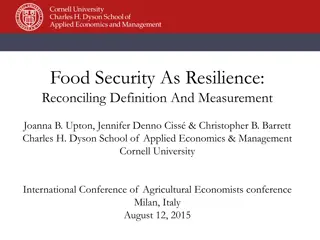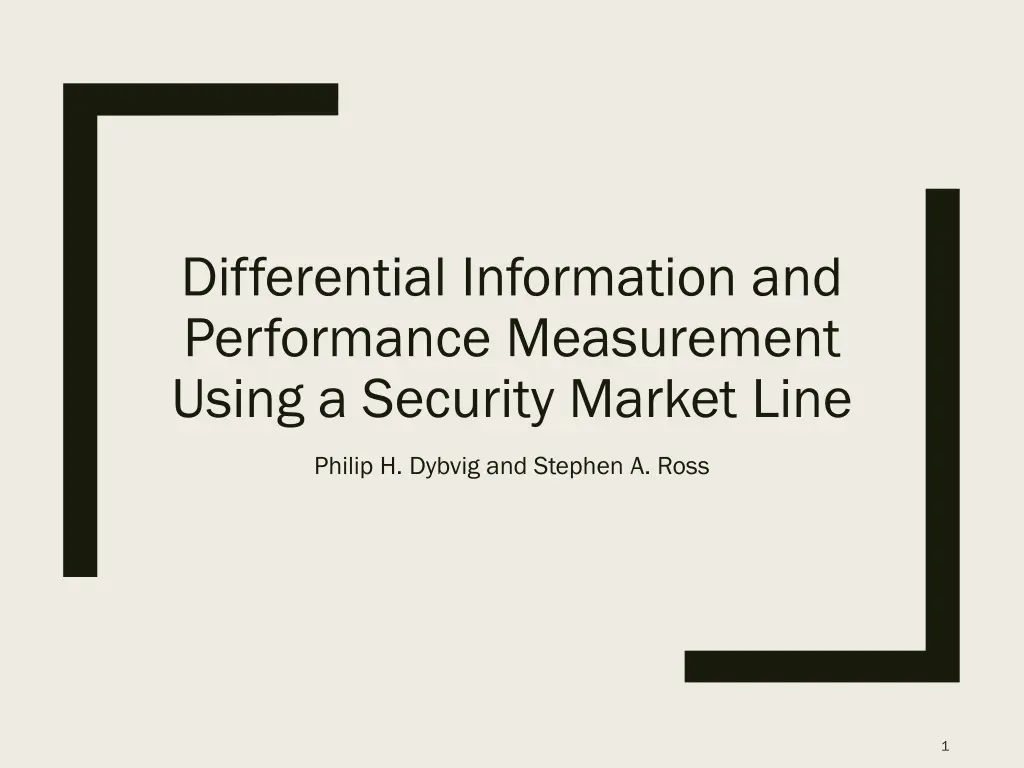
Performance Measurement Using Security Market Line
Explore how differential information impacts performance measurement using the Security Market Line (SML). The analysis delves into the implications of superior information on SML deviations and the challenges posed by market timing in SML analysis. Discover the nuances of informed portfolio selection and the validity of Mean-Variance theory in the context of the SML.
Download Presentation

Please find below an Image/Link to download the presentation.
The content on the website is provided AS IS for your information and personal use only. It may not be sold, licensed, or shared on other websites without obtaining consent from the author. If you encounter any issues during the download, it is possible that the publisher has removed the file from their server.
You are allowed to download the files provided on this website for personal or commercial use, subject to the condition that they are used lawfully. All files are the property of their respective owners.
The content on the website is provided AS IS for your information and personal use only. It may not be sold, licensed, or shared on other websites without obtaining consent from the author.
E N D
Presentation Transcript
Differential Information and Performance Measurement Using a Security Market Line Philip H. Dybvig and Stephen A. Ross 1
Content Introduction Introduction What can go wrong: using SML analysis with market timing Mean-variance analysis and informed portfolio choice What can go right: a positive theorem on the use of the SML An example without any riskless asset Conclusion 2
Introduction SML: Mean-variance theory predicts that if we plot expected returns against beta coefficients, all securities plot on a single line, known as the security market line. 3
Introduction This paper analyzes SML deviations caused by superior performance based on superior information. superior information: the portfolio manager may have information that is useful for portfolio selection, but is not possessed by the observer. This paper finds that differential information disrupts the validity of SML analysis. 4
Content Introduction What can go wrong: using SML analysis with market timing What can go wrong: using SML analysis with market timing Mean-variance analysis and informed portfolio choice What can go right: a positive theorem on the use of the SML An example without any riskless asset Conclusion 5
What can go wrong -use of SML analysis in presence of market timing Consider a model with 2 assets: A riskless asset with return r A risky asset with return ? = ? + ? + ? + ?, Where ?: a risk premium ?: signal observed by manager, ?~N(0, ??2), ??2> 0 ?: unobserved noise term, ?~N(0, ??2), ??2> 0 Assume r = 0 Utility function: ? ? = ? ? ?,A > 0 Manager s problem: given the signal s, choose ?(?) max?[ ? ?? ? (?+?+ ?)] 6
What can go wrong -use of SML analysis in presence of market timing Solution: Manager choice: ? ? =?+? ??2? By definition, unconditional abnormal return: ??= ? ? ? ? ? ??{? ? ? ? ?}, ? ?,? ? ? var ? ? ? Where ??=cov ? ??: beta coefficient of portfolio ? ? ? ? : market index or benchmark portfolio 7
What can go wrong -use of SML analysis in presence of market timing ? ? ? ? =?2+??2 ??2? ??? ? ? = ?2(??2+ ??2) ?? ??2?[2??2+ ??2] ??? ? ? ?,? ? = unconditional abnormal return Assume ?2 > ??2+ ??2 We have ??< 0. Therefore, the informed manager appears inferior on the basis of the SML analysis. 8
What can go wrong -use of SML analysis in presence of market timing Observed return of manager s portfolio: E ? ? ? =?2+??2 ??2? Observed variance of manager s portfolio: 2+2?? 4+ ?2+?? ??4? 2??2 4?2?? ??? ? ? ? = ?2+??2 ??2??, ? ? has the same return as Return to index ? ? is ??. so when ? = ? = manager s portfolio. ?2+??2 ??2?? 2 ??2+ ??2 ??? ? ? = So, ??? ? ? ? ??? ? ? = (3?2??2 ??2??2 ??4??2 ?2 ??6/?2)/??4? (1 When, ?2 > ??2+ ??2, (1) > 0. Therefore, manager's portfolio appears to the observer to be mean-variance inefficient since it has higher variance than a market portfolio having the same mean return. 9
What can go wrong -use of SML analysis in presence of market timing Why? Return to the manager s portfolio: ? ? ? =? + ? ??2?(? + ? + ?) =?2+ 2? ? + ? ? + ?2+ ? ? ??2? The term ?2 has a chi-squared distribution. Since this term is skewed to the right and bounded below, the manager views this part of the return more favorably than the manager would view a normal random variable with the same mean and variance. 10
What can go wrong -use of SML analysis in presence of market timing Let s reverse the assumption. Let ?2 < ??2+ ??2, ??<0. The manager will plot above the observer s SML. Thus, depending on the exact parameter values, this case may make the manager appear to the observer as mean- variance super-efficient, efficient, or inefficient. 11
Content Introduction What can go wrong: using SML analysis with market timing Mean Mean- -variance analysis and informed portfolio choice variance analysis and informed portfolio choice What can go right: a positive theorem on the use of the SML An example without any riskless asset Conclusion 12
Mean-variance analysis and informed portfolio choice In this example, we assume that an uninformed observer is monitoring the performance of another agent, the manager, who uses superior information in the form of an observation of an information state, s, to select a portfolio. If there are n assets, the managed portfolio ?(?) is an n-vector of weights summing to one in every state. ? ? ? = 1,? = [1, ,1] portfolio choice, ? ? , is efficient, conditional on s Conditional on information state s, the assets have an expected returns vector (s) and returns covariance matrix V(s). we also assume that the observer is completely uninformed and forms expectations rationally, 13
Mean-variance analysis and informed portfolio choice Let ? be the vector of random asset returns The observer's perception of average returns: ? ? = ??? ? ? = ??? ? The observer's covariance of returns: ???( ??, ??) = ? ( ?? ??) ?? = ????? Define ? = ??? ? , = ??[ ?? ??? ?, ? = ? + The observer sees as variability not only the average variability seen by the manager, V, but also the shift in the manager s mean across states, . In case of a perfectly informed manager, which V=0. the only variability seen by the observer is the shifting of the manager's true perception across information states. Since is positive definite, formalizes the sense in which the observer having inferior information implies that the observer faces more variability than does the manager, on average. = ? + ???(?? ? ? ?? ? ,?? ? ? ] ? ) 14
Mean-variance analysis and informed portfolio choice More general formulas to compute the means and covariance of return on portfolio ? ? and ? ? . Mean return: ? ? ? ? = ??{? ? ? ? } = ? ? ? ? + ???{? ? ,? ? } Covariance of return: ??? ? ? ?,? ? ? = ??? ? ? ? ? ? average conditional covariance + ???[? ? ? ? ,? ? ? ? ] covariance of the conditional means 15
Mean-variance analysis and informed portfolio choice By definition, the SML abnormal returns ?? to portfolio ?(?): ??= ? ? ? ? ? ??{? ? ? ? ?} ,where ??=cov ? ? ?,? ? ? var ? ? ? Excess returns using manager s expectation(i.e., expectations conditional on s) ??(?) = ? ? ?( ?) ? ??{? ? ? ? ?} ? ? ? ? ?(?) ? ? ? ? ?(?) ,where ??= If we could measure performance conditional on the manager's information, superior performance would register correctly in SML excess returns. 16
Theorem 1 Suppose that ?(?) is positively mean-variance efficient conditional on state s and that the return on a riskless asset in the economy is used for the riskless rate in defining abnormal returns. Then the conditional (on s) abnormal return ??? 0, with equality if and only if the index portfolio is efficient conditional on s. Proof: assume both ? ? and ?(?) have positive variance. Efficiency of ?(?) conditional on s implies that: ? ? ? ? ? = ??? ? ? ? ? ? , where ??? is the regression coefficient of ? on s. (14) Can be rewritten as: ? ? ? ? ? = [? ? ? ? ?]/??(?) (14) 1 Or , ??? = ??? ??? ? ? ? ? ? 0 17
Content Introduction What can go wrong: using SML analysis with market timing Mean-variance analysis and informed portfolio choice What can go right: a positive theorem on the use of the SML What can go right: a positive theorem on the use of the SML An example without any riskless asset Conclusion 18
Theorem 2 Suppose that: (a) There is a riskless asset, which is used for r in calculating ?? (b) In each information state s, the informed manager chooses a mean-variance undominated portfolio on the positive part of the efficient frontier conditional on s. (c) The manager does not learn anything about the return or variance of the uninformed observer s index, i.e., ?? ? and ??(?)? are independent of s (d) Expectations are rational and the rest of the framework is as given above. It follows that ?? 0, and equality holds if and only if ? is efficient conditional on every state (with probability 1) 19
Theorem 2 Assumptions (a) (b) (d) ensure that the conditions of Theorem 1 are satisfied. Therefore, ?,??? 0 and consequently ? ??? ,where equality occurs if and only if a is efficient conditional on all states (to be pedantic, with probability 1) Hence, ? ??? = ?? By definition, Proof: 0 ? ? ? ? ? ?? ? ? ? ??? = ? ? ? ? ? ? ? ?? ? ? ? ?[? ? ? ? ?] = ? ? ? ? ? ?? ? ? ??? Since ??? ?? = ??? + ? ? = ???, ??? ??,? ? ? = ?[?? ? ?(?)] ? ???[? ?,?(?) ?] ???(? ?,) =? ? ? ? ? ? ??? ?? ? 20
Theorem 2 Unusual assumption Unusual assumption - Assumption(c): The manager does not learn anything about the return or variance of the uninformed observer s index, i.e., ?? ? and ??(?)? are independent of s It shows that the manager's information does not help to predict the mean or variance of the observer's index portfolio. Mayers and Rice interpret this assumption to be an assumption that the manager's information is "asset- specific, in contrast to "market timing" information. The information helps to distinguish which assets have higher return or are less risky but does not help to determine the return on the market as a whole as held by the observer. 21
Theorem 2 A striking feature A striking feature - Theorem 2 never assumed that the portfolio is efficient from the point of view of the uninformed observer. Therefore, an observer with any index satisfying condition (c) will plot an agent with superior information on or above the SML. If we use an inefficient index satisfying assumption (c), we may find that an agent with superior information plots above, but others may plot above as well, which is simply to say that the power of the test in rejecting superior performance is less when the index is inefficient. 22
Content Introduction What can go wrong: using SML analysis with market timing Mean-variance analysis and informed portfolio choice What can go right: a positive theorem on the use of the SML An example without any riskless asset An example without any riskless asset Conclusion 23
An example without any riskless asset E.g.. three assets and two equally probable information states. The return vectors and covariance matrices in the two equally likely information states 1 3 1 2 3 3 2 1 1 1 3 5 3 2 1 2 2 3 2 State 1: p 1 =1 2 ? 1 = ? 1 = 1 0 1 1 0 State 2: p 2 =1 2 ? 1 = ? 1 = 24
An example without any riskless asset For uninformed observer, we have, 1 0 0 3 2 2 2 3 2 2 2 2 0 0 0 0 1 0 0 0 0 ? 1 = ? 1 = = Solution: The efficient portfolio for uninformed observer is ( ?,0,1 ?) Assume uninformed observer choose (1 2,0,1 2) The efficient portfolio for informed manager is State 1: ( ?,1 ?,0) State 2: ( ?, ? 1,2 2 ?) Assume ? = 2, so we have ? 1 = 2, 1,0 ??? ? 2 = (2,1, 2) 25
An example without any riskless asset The zero-beta rate for the uniformed observer is 1 2,0,1 1 2,0,1 ? = ? = 4 2 2 Then abnormal return is ??= ? ? ? ? r cov ? ? ?,? ? ? ? ? ? = 1 < 0 var ? ? It shows that a superior performer can plot below even when information is "security specific," provided there is no riskless asset. 26
Content Introduction What can go wrong: using SML analysis with market timing Mean-variance analysis and informed portfolio choice What can go right: a positive theorem on the use of the SML An example without any riskless asset Conclusion Conclusion 27
Conclusion This paper shows even in the absence of statistical measurement problems, a manager who makes optimal use of superior information may plot above, on, or below the SML and may plot inside, on, or outside the efficient frontier If the reference portfolio is known to be efficient, a manager plotting above the SML necessarily has differential information, but we cannot tell whether or not that information is being used correctly. With a riskless asset and a situation where the manager learns nothing about the returns on the uninformed observer's portfolio, the manager will plot above the observer's SML 28



